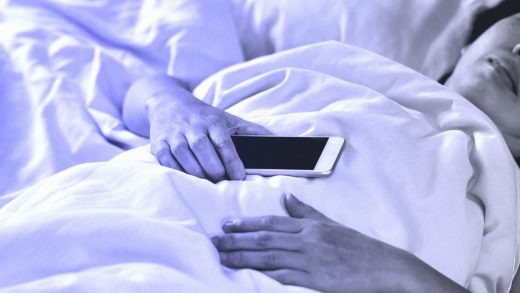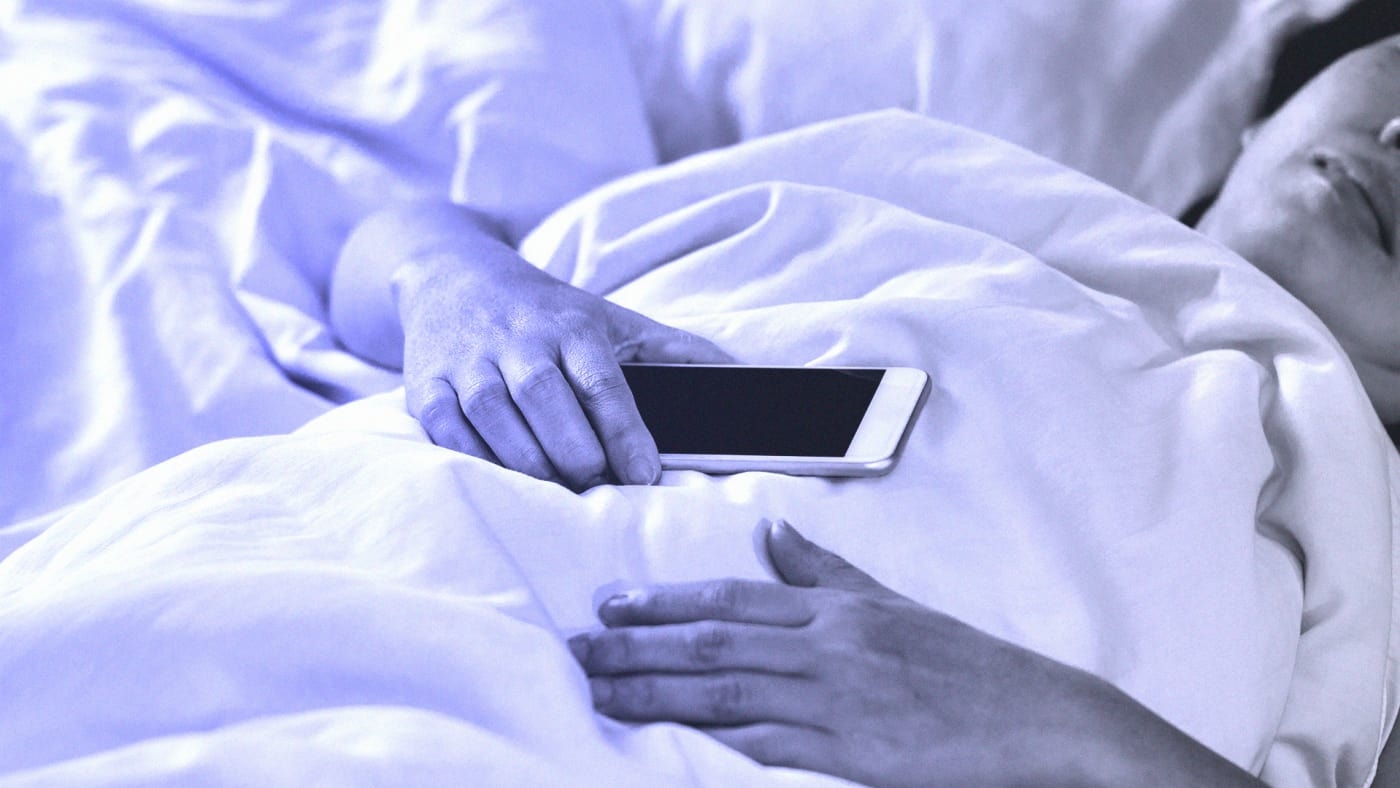The wide–and sometimes wacky–world of smartphone addiction cures
A few years ago, a smattering of kooky schemes, dubious proposals, weird hardware, and social shaming services relating to excessive smartphone use began to emerge on the self-improvement fringe. Fast forward to now, and the anti-addiction, anti-distraction movement has gone mainstream. The biggest Silicon Valley giants are even building special features into their products designed to get you to use their products less.
The issue these efforts aim to address is real. Motorola and Harvard psychologist Nancy Etcoff conducted a survey finding that one-third of respondents believe they spend too much time on their phones. Half say they check their phone more often than they want to. The survey also found people feel emotionally dependent on smartphones and want help with “phone-life balance.”
Numerous studies confirm that smartphone addiction is a problem because phones compel us to use it more often, and more disruptively, than we’d like. It can affect productivity, relationships, quality of life, and happiness.
Complicating matters, it’s not the phones people are addicted to, but the apps–most notably the crack cocaine of smartphone apps–social media. Smartphones aren’t addictive. But they’re powerful enablers.
Pavlovian notification alerts and red “messages waiting” icon badges trigger a zombie-like compulsion to dive down a smartphone app rabbit hole at every opportunity. We carry them everywhere. And when we get bored or want to procrastinate, we can always find ways to temporarily satisfy our cravings.
There’s no question that smartphones and the apps we use can get us to spend more time, and interrupt Real Life more often, than we’d like. The question is, what’s the best way to curb smartphone addiction? There are five basic approaches, and products that fall into each category.
1. Go cold turkey, or close to it
Last year, a designer named Klemens Schillinger created a device called the Substitute Phone. It’s the same size and shape as an actual smartphone, but with stone beads on it instead of a screen. The abacus-like beads are arranged so that running fingers along them in a row simulates the poking, swiping, and pinching gestures used to control a touch screen on a smartphone.
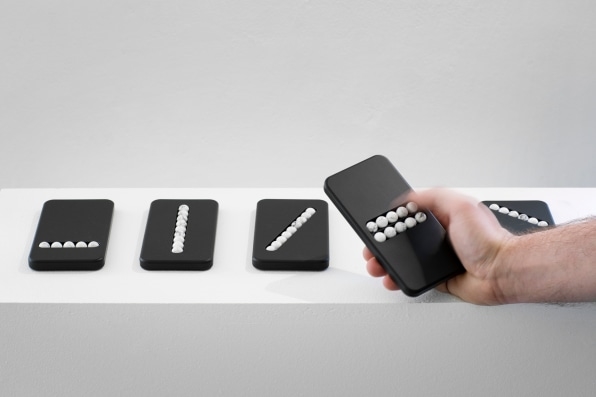
[Photo: Leonhard Hilzensauer, courtesy of Klemens Schillinger]
The dubious notion behind this concept is that people are somehow addicted to swiping, not Snapchat, and if the cure for smartphone addiction is getting off phones completely, a dummy device eases the transition to your new phone-free lifestyle.
The Substitute Phone idea is going nowhere. But others are making phones that actually are phones–and almost nothing else. The Light Phone 2 may be the most practical in this category. It’s a tiny, minimalist phone with an E Ink touch-screen. When it ships next year, it will have two basic functions: phone calls and text messages.
Light Phone co-founder Joe Hollier told me that the device may also get Google Assistant, maps, music, and possibly Uber–and nothing else. Unlike the first Light Phone, which was designed as a temporary crutch for going for a few hours without a full-featured smartphone, the next Light Phone is designed to replace a smartphone completely.
Other concepts take a similar approach. A Serbian design studio called Alter Ego Architects invented a close-to-credit-card-size dumbphone–a phone with only numbers and symbols and with no apps to encourage addictive usage. The phone concept keeps costs down by using 3D printing in the manufacturing. It also uses an E Ink screen.
Solutions that call for permanently giving up smartphones may not be practical. That’s why some try to get people to give up their phones only temporarily and occasionally. A designer named Matteo Bandi came up with a radical concept: Create household devices that require exclusive use of your phone in order to function. The appliances, called “Sidekicks,” include a lamp, alarm clock, speaker, and projector for watching TV.
To use any of these devices, you must insert your smartphone, making the phone unavailable. When you remove the phone, the device stops working. For example, you can use your phone or listen to music, but not both at once. (Unless, of course, you use your phone to listen to music.)
An associated app keeps track of smartphone use, and the devices reward you. For example, the lamp celebrates your phone abstinence with a light show.
The Sidekicks idea is just a design concept, and will probably never emerge in actual products. But real apps that get you to take breaks from your phone do exist. Nick Kuh, the creator of an app called Mute, told me his app focuses on “digital detox” goals that you reach by keeping off your phone for a set amount of time, ranging from 30 minutes to a full weekend.
Kuh arrived at the idea when his own teenage son called him a hypocrite. Kuh and his wife had imposed screen time limits on their son without imposing any on themselves. The son noticed and called him out on it. So Kuh came up with Mute as a way for everybody to impose screen limits on themselves.
Just Mute It is free, with a planned future Premium option with additional tools for breaking bad phone habits “in the coming months.” Kuh says he’s also working on a version 2, which will have new achievements and challenges, including a Mindful Morning achievement for not checking your phone before 8:30 a.m. three days in a row.
Then there’s the popular app called Freedom. It blocks addictive apps and websites for amounts of time you specify, and works with both desktop web browsers and mobile devices. Using it on all your devices costs $2.50 a month.

2. Quantify your usage
Ultimately, abstinence is a lot to ask. Maybe people will cut phone use if they have a more accurate picture of how they’re using their phones. With that in mind, major Silicon Valley companies have recently jumped on the anti-addiction bandwagon, informing users with data.
The new version of Android, Android Pie, offers a feature called Dashboard, which shows how much time you’re spending on your phone, and on which apps. It also comes with App Timer, for setting app-time limits, Shush is a Do-Not-Disturb feature effected by turning your phone face down, and Wind Down fades phone colors to gray as your scheduled bedtime approaches.
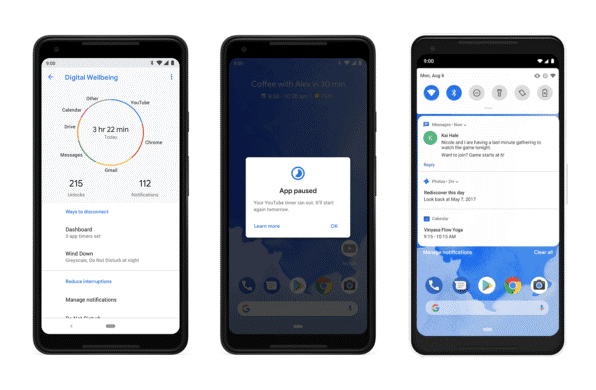
[Animation: courtesy of Google]
Apple’s upcoming iOS 12 offers a range of new features for coping with smartphone addiction and distraction. The new Activity Reports show time spend in each app, plus the time spent in categories of apps–for example, how much time you’ve spent playing games. It also tracts when the phone interrupts you, both counting notifications and the number of times you pick up the device.
For users who want to limit how much time they spend on various activities, iOS now offers a Screen Time feature. Apple also added anti-addiction features to its Siri virtual assistant, which can now suggest less distracting notification settings.
Even Facebook is getting into the act. Both Facebook and Instagram recently got new settings called Your Time and Your Activity, which chronicle the time you spend on the Facebook and Instagram apps and give you options for limiting use.
The Facebook features are far from comphrensive, however. For example, they’ll show usage on a single app, but not across apps. The iPhone app tells only about iPhone usage, and doesn’t include iPad usage. And Facebook doesn’t offer the service for web browser access.
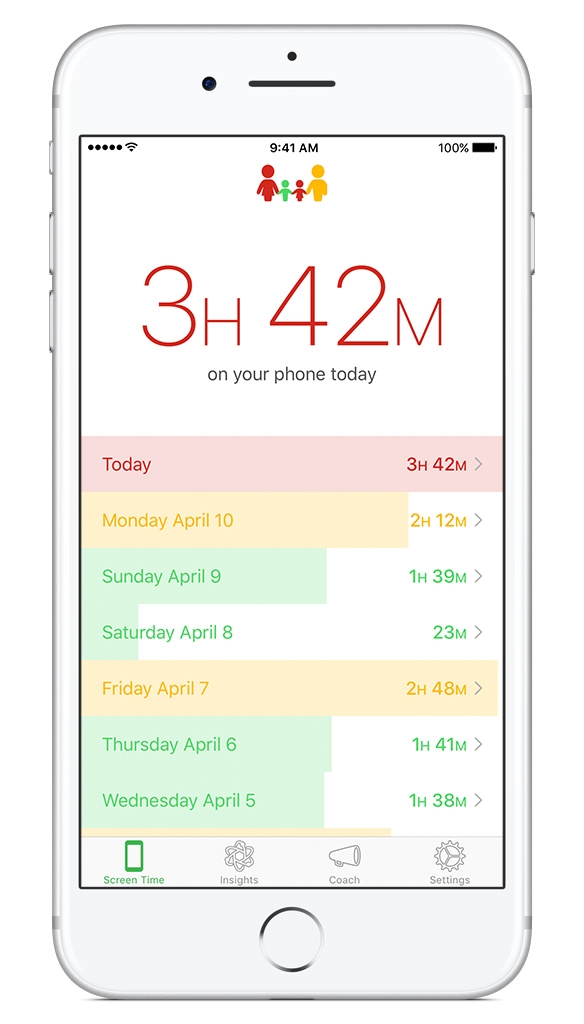
In focusing on measuring activity to make users aware of how they’re really using their phones, the Silicon Valley giants are offering features that have been available in third-party apps for years. Kevin Holesh started working on an app called Moment five years ago. Moment tracks phone usage and presents you with details about usage.
After getting married, Holesh and his wife became concerned about how much of their time together was spent with each of them glued to a phone. His epiphany was to build an app to measure it.
Holesh told me he discovered the same alarming fact his users eventually would: Time spent on phones tends to be triple the amount assumed. He thought he spent an hour a day on the phone: “Turns out if was three. Everyone underestimates their time.”
Moment uses the freemium model. Basic functionality is free, but the Premium version costs $4. For that, you get something called “The Coach,” which gives tips and advice for cutting smartphone use. The information and coaching in the Moment app aims to get people to cut smartphone use to “about a half hour a day.”
Moment is for iPhones only, with an Android version planned for a fall release.
3. Make it boring
Smartphones are fun and appealing. That’s why some approaches curb smartphone addiction by daring to be dull. Siempo is an Android launcher that makes your phone boring with a white background and bland icons. It also lets you delay and cluster notifications.
And here’s a new twist on reducing compulsion: Siempo constantly rearranges icons so you can’t form the muscle-memory habit of reflexively launching the apps. You have to work a little each time to find the icon.
The intent of the app is to suppress the attributes of a smartphone that make them addictive, disruptive and distracting–to “reduce unconscious usage,” according to Siempo CEO Andrew Dunn. The company is looking for smartphone makers to sell phones with Siempo as the default interface.
Dunn is also involved in two related campaigns. One is a petition to pressure Apple into giving third-party developers such as Siempo access to parts of iOS that would enable Android-like anti-addiction features. The other is a “Digital Wellness Warriors” Slack channel, where software developers and others working to make smartphones less harmful can collaborate.
Another startup, LA-based Dopamine Labs, was founded by two neuroscientists who built an anti-addiction app called Space. Which is an interesting twist given that the company’s main business is helping other companies make their apps and sites more addictive.
Space kills the instant gratification of launching an app. After a quiz that identifies what kind of addict you are, it delays the launch of the addictive apps, and calls for you to “take 1 deep breath.” The more you use the app, the longer the delay becomes. It’s free on iOS and Android and also as a Chrome extension. A for-pay premium version with extra features is coming soon.
4. Gamify your way to moderation
Making your phone boring might make your life more interesting. Or you can gamify the reduction in smartphone usage. Maths Mathisen, CEO and co-founder of Hold, told me his app uses external incentives and gamification to curb excess smartphone use.
Hold incentivizes through competition. Designed for students, it encourages you to compete with others over how long you can go without using your phone. In doing so, you earn points which can be used as currency to buy snacks and movie tickets from Hold’s partners. The app is free, and partners who offer the rewards pay a monthly subscription to be part of the platform.
It all started when Mathisen was himself a student. In order to encourage each other to focus on studying for a test, he and some friends agreed that those who checked their phone first had to buy the rest a cup of coffee.
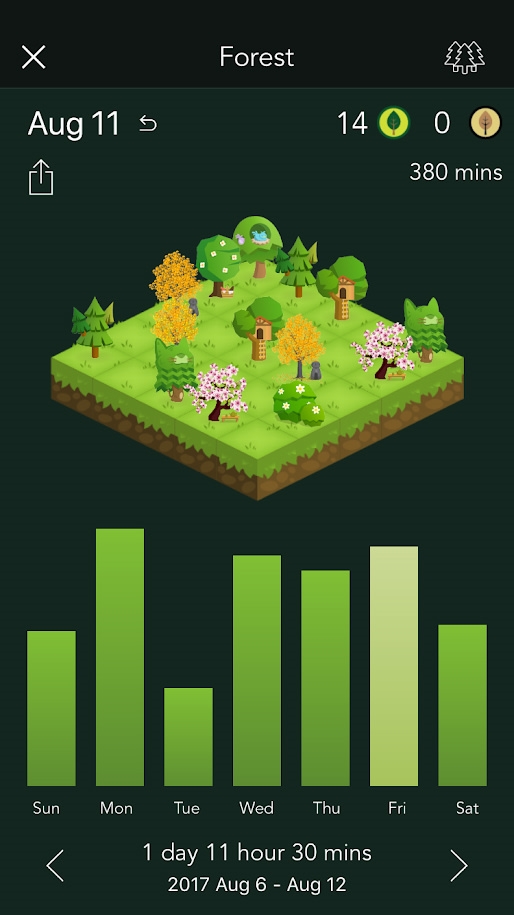
Another app called Forest lets you set a timer for the amount of time you want to focus on something. In doing so, you plant a virtual tree. When you’re triggered to indulge in your smartphone addiction, the first thing you see is a growing tree with some words of encouragement to stick to your task. If you ignore it and continue on to Facebook or some other addictive app, the tree dies. By focusing on your task, the tree grows and becomes part of a virtual forest, with each tree representing a successful uninterrupted task completion.
Each time you grow a complete tree, you earn virtual currency, which can be used to buy other kinds of trees and plants–or as a donation to plant a real tree, in partnership with Trees for the Future.
Shaokan Pi, the creator of Forest, told me that it’s based on the “Hook” model, which says that users are triggered by boredom or procrastination and take action to seek out smartphone distraction, for which they are “rewarded” by a dopamine hit to the brain. “Forest stops users at the Action stage in the hook model,” according to Pi, replacing the “reward” of dopamine with the reward of a sense of achievement as represented by the growing forest.
Forest costs $1.99 on iOS. It’s free on Android, unless you upgrade to a $1.99 premium version with all the same features as the iOS app. There’s also a Chrome extension.
5. Bring on the peer pressure
An app in development called SwitchKick uses good, old-fashioned peer pressure–or what the developers call “social support.” The iOS app, which is being crowdfunded until August 22, lets you earn points by reaching your own goals for staying away from your phone. You do this in the context of social groups, which you form with other users for moral support and accountability. (The company is also working on an Android app.)
Another iOS and Android app called Lilspace lets you earn perks for staying away from your phone. When you start using the app, you’re called upon to participate in various causes, such as providing houses for the homeless. You support those causes by meeting your goals for staying off the phone.
Do these products and ideas work? The answer is a resounding: maybe! It really depends on how motivated you are to break the addiction, and what kind of personality you have. As with anti-smoking remedies, each approach has adherents who swear it works for them, and also users who claim it didn’t.
So whether your best approach is abstinence, data, dullness, fun or peer pressure, there are plenty of solutions for breaking smartphone addiction. The trick is to experiment and find the right solution that works for you. Of course, that’ll require some extra time on the phone.
Fast Company , Read Full Story
(32)

